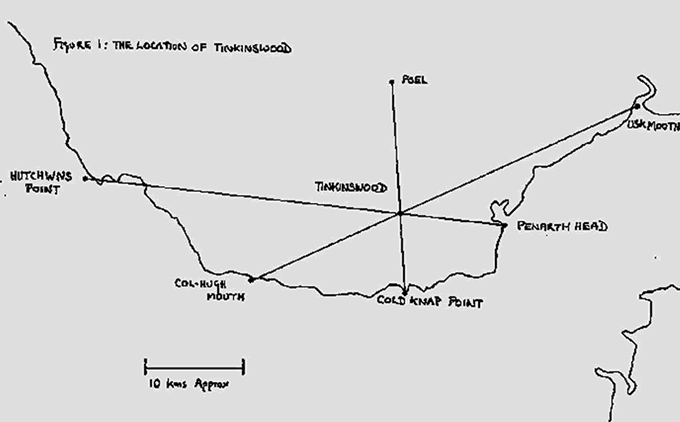
THE PRECISE LOCATION OF THE CAIRN
The Ordnance Survey Map confirms that Tinkinswood is precisely located at the intersection of three imaginary lines linking six key geographical features: three coastal points, two river mouths and one mountain top.

Fig 1 - Tinkinswood is Related to Six Key Geographical Points by Three Imaginary Lines
The first of these imaginary lines (the ‘Rivers’ line) runs across the Vale from the south-west to the north-east between the mouth of the Col-Huw river at Llantwit Major and the mouth of the Usk at Newport. The second line, (the ‘Mountain’ line) runs from Foel, a hilltop near Llantwit Fardre, to Cold Knap Point near Barry. The third line, (the ‘Coastal’ line) runs west to east from Hutchwns Point near Porthcawl to Penarth Head. Both the ‘Rivers’ and the ‘Coastal’ lines are exactly one thousandth of the earth’s circumference in length while the ‘Mountain’ line is precisely half this length. You can obtain further details, map references etc, about these lines by clicking on the links below.
One thousandth of the earth’s circumference is 40 kilometres. Clearly the Neolithic people did not measure in kilometres. We have no idea what they measured in. All we can say is that the ancient measures of the pole (5.5 yards or about 5 metres) and the Celtic League (500 poles or about 2.5 kilometres) turn out to be very useful measures when it comes to measuring the distances between ancient sites. Henry Lincoln first drew attention to the possible link between ancient sites and the pole in his book ‘The Holy Place’ in 1991*. If we measure these lines in poles then we have: the ‘Rivers’ line – 8,000 poles; the ‘Mountain’ line – 4,000 poles; the ‘Coastal’ line – 8,000 poles. The significance of this will become apparent on the next page – Precise Ratios.
To learn more about how we measure these imaginary lines click on the links below:
NEXT: Precise Ratios
BACK: The Great Cairn at Tinkinswood
MORE DETAIL:
The Pole - an Ancient Unit of Measure
More Details about the Tinkinswood Burial Cairn
* Henry Lincoln, The Holy Place, Jonathan Cape, London, 1991